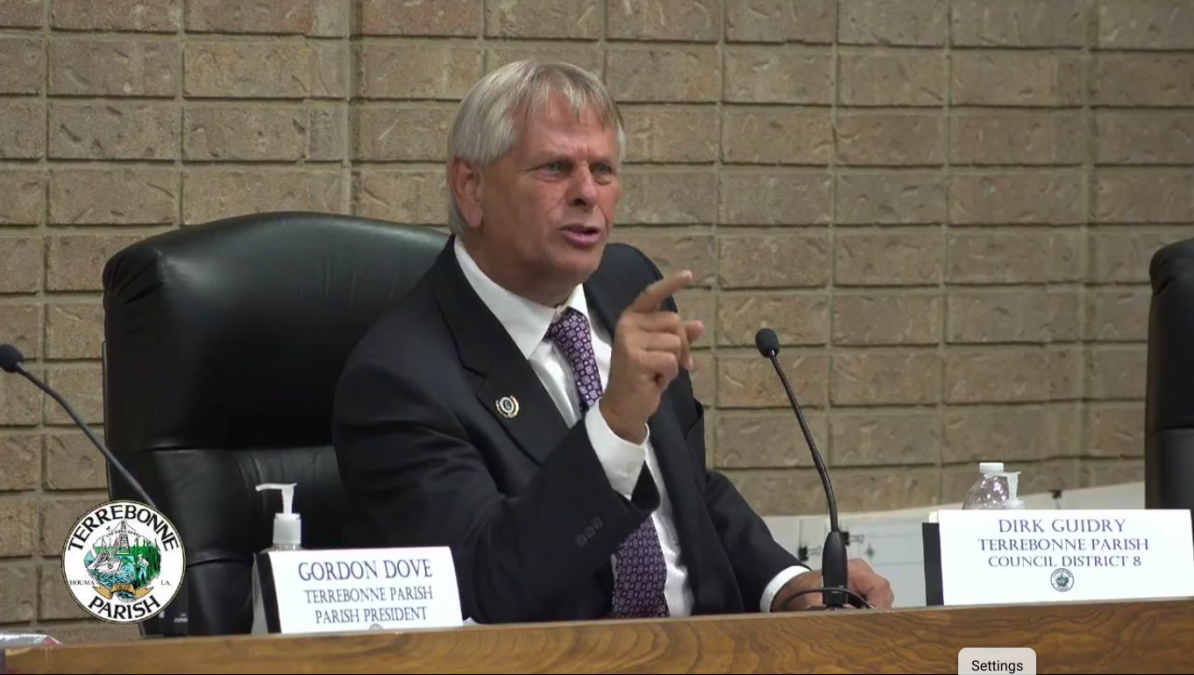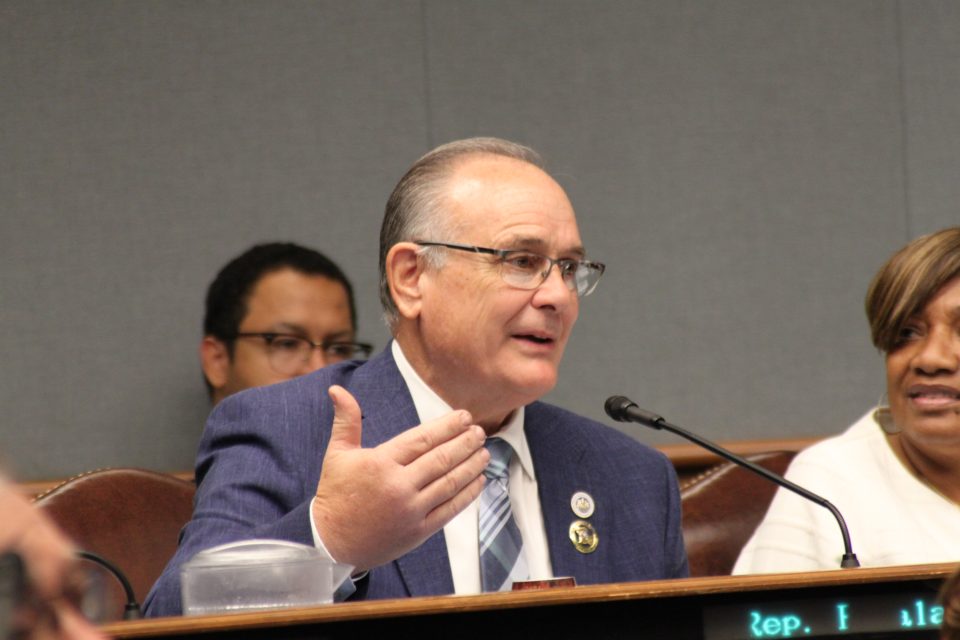
New Flexible Admissions Policy Increases Accessibility to Nicholls State University
December 6, 2021
Peltier Foundation donates $50,000 to Hurricane Ida Recovery for Nicholls Students
December 6, 2021Things got emotional at the last Terrebonne Parish Council meeting as the council was able to address representatives from APTIM, FEMA, Entergy, and Louisiana’s Commissioner’s Office.
It was put into motion to add a subject to the agenda to speak to the representatives so that council members could better understand the processes of both the federal and the state housing programs. I also allowed them to be able to ask questions they have been wanting to ask for quite some time now. The first representative to be introduced was APTIM Project Manager Amy Courville.
APTIM is the contracted company for the state housing program. Although they are known to be an engineering company, they also have over 40 years of disaster experience. They have managed over 22 emergency response programs and are the largest haul and install design/build contractor for the federal government and FEMA.
Courville said they are trying their hardest to get homes to survivors and noted that the program is a first of its kind. They have a process to coordinate housing to residents which Courville said they are never satisfied with the numbers of trailers going to survivors and always strive to do better. The five-step process begins when the storm actually hits. She said the state realized there was going to be a large need and said jumping from step two, to find emergency shelter, to step four which is to find temporary housing, will take too long. They worked with FEMA and the parishes to find out what solutions the communities wanted. The solution that was the most popular was to get trailers put on survivors’ properties. The state was able to coordinate with FEMA to get the approval of a program that created step three in the process: the Hurricane Ida Sheltering Program. It is the first time this type of program has been implemented in the nation and Courville noted there’s no playbook for the procedures, but there are playbooks for disaster recovery and how to think innovatively. Courville said they are very familiar with FEMA’s program and the steps that are involved in their process. She said they are always open for discussion and recommendations on new efficiencies to make the program more efficient.
She reported the program was open for registration on Oct. 4, 2021, which was seven to ten business days from them being accepted after a competitive solicitation as the state contractor. Terrebonne council members helped consolidate lists of constituents that needed housing assistance which was questioned by some of the council members and the first two weeks of the program consisted of providing shelter for first responders. The first two weeks also consisted of working with the parish to find what exactly was needed and what the process going forward would look like. The next step in the program journey she said is an eligibility review which makes sure survivors are eligible for the program. This step asked questions such as ‘is your property damaged or destroyed?’ ‘Do you have a permanent housing solution because they cannot duplicate benefits?’ She noted that the next step is important and is where many pieces of the puzzle come together to get residents in temporary housing. The shelter solution selection step begins the process of finding the solutions for housing such as finding out if those in need have private sites for a trailer. If the land is not owned by them, they must have the signature of the landowner. Courville also noted that there are three pieces of information needed for registration:
- A copy of your government i.d.
- Release of Information document
- Right of Entry document.
The Right of Entry document is the landowner’s agreement to lease in and it’s an agreement to the terms.
After these are provided and they have everything in order, the next step is to get a site inspection done. They don’t schedule appointments because they said it slows down the process. This is when the Right of Entry is important because they go down a list of inspections and go house to house. If the survivors did not provide the document, they tell them to be at the property from 7 a.m. to 7 p.m. on a certain day so they can be there for the inspection. She reminded that these inspections are not damaging assessments, they are inspections of the sites to make sure they are sufficient to house the trailer and help find the best solutions for individual families which she said varies greatly. They also check if the units can be connected to power, water, and sewer safely. Courville said the inspection is done within 24 hours and the sites are either deemed feasible, infeasible, or feasible pending action. Feasible pending action means an action is needed before the unit is placed such as debris removal.
Courville said they then identify a unit that best matches the family’s needs. “This isn’t mobile homes,” she reminded,” that’s not what this program is. It’s temporary shelter.” After the unit is selected, there are still more processes that need to be done. Step four is when APTIM starts contacting the residents to ask if everything is working properly with the units. They provide preventative maintenance inspections once a month and noted there’s a number they can call if they have maintenance issues with the units, 1-844-268-0301. They also regularly follow up with the survivors to inquire about their long-term housing plans. Step five is when they call APTIM and report they have found a solution and are ready to move out. This is when they schedule a move-out date, conduct inspections, remove the unit from the property, and the survivors’ transition to their long-term housing recovery.
Courville then reported some statistics which were provided by the survivors. In Terrebonne Parish, there have been 5,274 total registrations. There have been 659 units deployed and 403 of those units have been leased in. There have been 940 private site inspection completions and 30 commercial/group sites. Why is there a big gap between units deployed and those who have been leased in so far? They broke that down even further. Courville showed that of those registrations, there have been 2,815 majorly damaged or destroyed homes. 1,488 registrations are incomplete, 534 registrations are under review, 227 sites are pending inspection, and 161 are pending shelter delivery. Of those 403 units that are leased in, they are housing 1,215 people. There’s an average of three members per household. When residents call to get a status, they could be confused by status definitions, and Courville broke those down to make them easier to understand. Registration incomplete could mean several things. It means that the registration has unanswered questions or missing documents. Registration requires a FEMA number, full name, damage property address, phone number, a response of whether or not it’s owned or rented, response if they want to be sheltered on private property, a response to the number of people in the household, and their ages and genders.
She reported one-third of the residents are in the haul and install window. Courville explained that a work order is confirmed and sent out within 24 to 48 hours of a confirmed feasible site. Once the unit gets on site, Courville said they have about four days to install utilities, an inspection of the unit after connections are made, a COVID cleaning, and then the survivor is contacted to sign a lease-in. She explained that around 80 are in the 4-day window of installation. There are around 80 units that are onsite and everything is hooked up except for the electricity.
Fact Vs. Fiction:
If you don’t have power service to your home and you need the power to be brought in, the program will provide install and pay for a temporary power pole. She said they coordinate with the Parish and they coordinate with the electrical companies to put the meter on. “The only thing that the survivor needs to do,” she said,” is to contact their electricity provider and say I (name) authorize the second meter to be put on my account.” She said the rest of that gap that needs to be leased in is separated into two categories: those who have been demobilized because the survivor has accepted the unit initially but now has a different solution, and those who have not accepted the lease-in yet because they are weighing other options.
On average, she said 100 site inspections happen per day, 50 unit deployments a day, and 50 lease-ins throughout the state. In Terrebonne Parish, they are roughly deploying half of what they are deploying in the state here. That means on average they have 22.5 deployments per day and 13 lease-ins per day. Following Courville’s report, it struck up conversations that pinpointed that communication has been a big issue when it comes to the pace of services. There has been an ongoing problem with miscommunication when it comes to those delivering the trailers and survivors who may misinterpret the given information. It was noted by District 9 Councilman Steve Trosclair that they need to work on the communication issue and Courville confirmed they will be contacting people to find out how the wrong information is getting out.
District 5 Councilwoman Jessica Domangue brought up that she was concerned about the number of people that are housed, 403, and the total number of registrations, over 5,000. She said she’s also concerned that there are more non-homeowners than there are homeowners. This brought up a question regarding the upcoming Rebecca Plantation group site. Courville answered pointing out that just because someone is registered with the program, they may also have other options available to them. She noted that the state is also working with other resources to see if they have other options for them, such as HUD housing, to identify their needs. She answered Domangue by announcing a date of December 16 for survivors to be able to be moved into the Rebecca Plantation group site. It will work in phases meaning pads will be available as they are finished and people will be moved in as soon as they are not in the way of ongoing construction. In the meantime, they are reaching out to people to see if their needs are still prevalent and if their information is still accurate.
District 8 Councilman Dirk Guidry came in strong with his concerns especially regarding the time it takes from deployment to getting residents in the units. He passionately brought up that there are some people not worried if the electricity is hooked up, they have been staying in tents and under their elevated houses, so a unit with no electricity is a haven compared to what they have been dealing with the past few months. “We need to streamline the process somehow. It needs to be faster,” he said. Chris Pulaski, Executive Director of the Terrebonne Parish Planning and Zoning Department, commented that the rate per day of unit deployments is rising. He then introduced a FEMA representative to address the council.
Philip Price, the Direct Housing Unit, Logistics, and Manufacturing Housing Unit Lead, began explaining the special flood hazard areas. Usually, FEMA did not allow units to be placed in special flood hazard areas. When Hurricane Laura hit, they had the same issue in Cameron Parish, and it was decided to waive this rule. Starting November 18, they decided that was also needed in Terrebonne Parish. Mobile homes can be placed with a base elevation of 44 inches. He said of the registrations, 2,390 registrations have been reviewed by the National Processing Center. Another 197 registrations need to be reviewed and 602 have denied the offer because they stated that they have already found another housing option. He said that before the special flood hazard rule change, they had 550 declines. Since the rule change, they are reviewing those cases again to get them ready for work orders. As of the meeting, FEMA issued 148 work orders for Terrebonne Parish for the installation of units. He also let the council know that if someone they know of is living in cars, tents, or makeshift homes, to let Pulaski know because those cases become the priority with FEMA. “We just don’t know. We’re sitting there in Baton Rouge and not here in the parish on a day-to-day basis. So if you have people that really need help and need it soon if you let us know, we will do our best to make them priorities,” he said.
Price explained that there are 14 days from the time a work order is issued for a mobile home to when it is ready to be powered up. He said before the unit is brought to power, they must bring out a generator, run it for at least four hours, and inspect to see if there are any issues with anything. He said they have been running into issues regularly that they don’t initially see in the site inspections is sewer issues especially in areas where they had flooding. He said generally those septic systems are non-functional. They tend to be filled with silt and have to be pumped out. Another issue they have been running into is lift stations. The runs they are having to make with the sewer lines sometimes the fall does not meet what they need to be, so they are having to install lifting stations. It is issues such as these that add time to getting survivors in units. It was also reported that there are now FEMA representatives embedded into the Planning and Zoning office to have better communication and coordination between the parish and FEMA.
Three Entergy representatives addressed the council next and emotions were heightened. Representatives present were Sean Quinn and Vice-President of Customer Service Ivanka Daniel.
Daniel started by explaining the process of getting energy to units. First off, there needs to be an account set up by the customer, they need a permit, and they need the contractors doing the work to follow Entergy standards.
They are increasing the number of resources to help turn the power on for customers and are doing additional hours. She urged once again to spread the toll-free number, “we are dedicated to make sure that this process works properly. They have already been through a lot,” she said,” and we don’t want to make things harder for them.” Arnold then presented the process of turning the power on along with pictures of the issues they have been having. He explained the customer flow, first, the customer must have an account set up. He then said the facility must then be present and they must meet Entergy standards. Once the permitting agency releases it, they go to inspect the property, and he said they must match. If there is an issue and the resident isn’t home, he said they leave a door tag that has information such as if it’s a standards issue or something else. He said they typically don’t go to the property unless all of the boxes are checked. He shared an example of the standards and said they already share it with FEMA and APTIM will start to share them with all of their contractors.
Another issue the council brought up was street lights being out and not being repaired which causes hazard concerns. This was followed by a response from Arnold, “There’s no doubt that you want all of them fixed, I understand that, but if we want to connect and prioritize specific affairs that you would like us to focus on first, we’d be happy to do that.” Councilman Trosclair asked about additional contractors to come in to help with the process, “Why not bring them in,” he asked,” we had thousands of contractors here before.” Arnold said they don’t want people to sit idle, so, until the problems with the prerequisites, they wouldn’t have work to do. “We had 2,400 contractors in Terrebonne Parish…having that many people here now, you would have people sitting idle because there is not that much work here for them.”
They reported they have about 25-30 percent of people calling about some sort of issue for temporary power installations. Councilman Guidry was next to address the Entergy Representatives and came in heated about the company not maintaining the poles before Ida. He said they had poles “that were rotten and ready to fall down and all y’all had was a little company before the storm that were changing all the poles down in Chauvin, and they were changing one and a half poles a day. The guys told me it would take them over a year to replace all of the rotten poles that you guys failed to maintain in a deplorable condition because a lot of them are rotten.” He continued to say that a lot of the outages that were present after the storm was Entergy’s fault, and his anger visibly increased as he addressed the representatives, “and now as a business, you’re going to come back and make my people, and me, pay an $11 a month or more for what I believe for 15 years! How can a company come back and have damage and expect the consumers to pay for it,” he said. He called out the company, “you guys run a bad company,” he said while pointing to the representatives, “we wish and pray down the bayous that we have SLECA because you guys have run a bad company…you people need to go back to the drawing board and try to help the people, not go and charge them $11-$12 a month for 15 years because y’all did not do your job!”
Next to address the council was Louisana Commissioner Dr. Craig Greene’s Chief of Staff, David Zito. Zito began by saying he’s going to take the conversation back to Dr. Greene’s office so they can get to the drawing board to figure out how to get more results. What the Commissioner’s Office does in the process is regulate and coordinate the trailer home installations. He began by saying he wanted to note that APTIM and FEMA did not suggest that they weren’t able to coordinate with Entergy, but they will do follow-up calls to ensure if they are more willing to speak privately about the issue because he said it’s important to know how many of the trailers need to be connected that are not connected on Entergy’s front. He said that the number of people without power they are just realizing is baffling and disturbing.
When everything was said and done, everyone concluded that there’s one major issue in the whole process: communication. Councilwoman Domangue said “What we would all like to see moving forward is that we work on communication and we work on communication from the top down. Whatever you and the Commissioner can do to ensure that whatever is happening with the different companies, that it is then given to the local level because we were in the dark in more ways than one.” Council Chairman Daniel Babin concluded the three and a half hour meeting and said, “We heard a lot of things from us tonight. It’s just frustration,” he said,” All of these agencies need to coordinate better so we, in turn, can get people in trailers and some temporary housing, then FEMA can get them into long-term housing, and we can work on the real long-term housing.”









